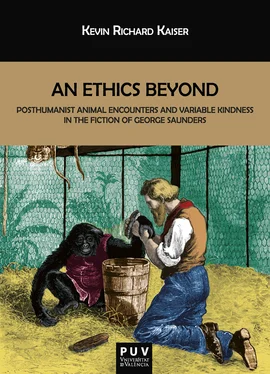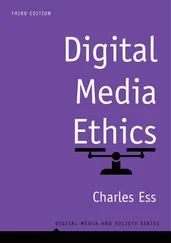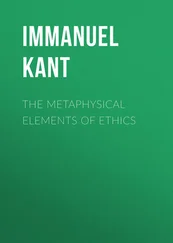Before addressing his fiction, I devote Chapter 1 to Saunders’s position in contemporary American literature as a satirical and ethical author, then proceed to Chapter 2, which focuses on notions of posthumanism, as formulated by various theorists, and how these concepts relate to nonhuman animals, the development of posthumanist ethics, and Saunders’s fiction. I then move on to cover the fiction, analyzing one text per chapter—except chapter 5, which examines two—in order to demonstrate how the fiction relates to posthumanist ethics, as well as human and nonhuman animal relationships. Thus, Chapter 3 is an analysis of the short story “The 400-Pound CEO” from the first collection, Civilwarland in Bad Decline (1996). The story, narrated in first-person, concerns an obese man who works for a sadistic employer at a raccoon retrieval operation that kills the raccoons it supposedly rescues and frees. My analysis focuses on how Saunders’s satire of American culture also functions critically, as well as on how his fiction, by being “experiential,” helps the presentation of ethics. Furthermore, I examine how humans determine who is ethically “worthy” and how the story complicates questions of what is ethically “right.”
I follow in Chapter 4 with an analysis of the titular novella from the second collection, Pastoralia (2000), which concerns the lives of two characters, the passive narrator and his rebellious colleague, both of whom work and live on display in a theme park, confined to a simulacrum of a cave, where they are supposed to behave like stereotypical cavepeople. I begin with an inquiry into what language is—that is, as a system of communication that is frequently touted as being exclusive to humans. I then explore how philosopher Jacques Derrida’s notion of “carnophallogocentrism” pertains to the novella. Finally, I take up the problem of utilitarian ethics espoused by the company in the novella.
Chapter 5 is concerned with Saunders’s children’s story, The Very Persistent Gappers of Frip (2000), and a novella, The Brief and Frightening Reign of Phil (2005). Both read somewhat allegorically, despite the differences in their target audiences. The former is about a girl who, tired of removing creatures called “gappers” from goats so that the goats will give milk, decides to learn to fish. Her neighbors, who at first refuse to help her, eventually seek her help. My analysis examines the book presents some of the more traditionally humanist tendencies Saunders usually evades in his writing and how, in the story, human livelihood is dependent on the enslavement or killing of nonhuman beings. I follow this brief analysis with another one focusing on a novella about abstract beings called “Hornerites.” When the Inner Hornerites accidentally “invade” Outer Horner, Phil, a rancorous Outer Hornerite who calls the Inner Hornerites a threat, gains support, takes over the presidency, and attempts a genocide of the Inner Hornerites. For my analysis of the novella, I investigate both the published text and the outtakes included on the website, < www.reignofphil.com>, addressing conceptions of who is considered human and how the language and practice of genocide are related to our conceptions of nonhuman animals as inferior.
I return to the short story collections in Chapter 6, which focuses on the story “93990” from In Persuasion Nation (1996). Written as a toxicology report, it is narrated presumably by a scientist who is conducting tests of a drug, the purpose of which remains unstated, on a group of monkeys, each of whom dies or is sacrificed after demonstrating a series of hideous behaviors caused by the effects of the drug—except for monkey 93990, who is immune. I use the opportunity in this chapter to explore the routine sacrifice of nonhuman animals for the sake of human well-being and the role of the biomedical industry, known as Big Pharma, in the United States, as well as the Judeo-Christian influence on notions of life and death. I also dissect how the story’s use of passive voice is indicative of that found in biomedical reports, generating the false sense of an impartial observer.
In Chapter 7, I analyze the story “Puppy” from the most recent short story collection, Tenth of December (2013), which features Saunders’s “ventriloquist” technique, a third-person narrative style that can render thoughts in the first person. The story alternates between the intertwining plotlines of two female characters and their familial concerns. As one woman plans to take home a puppy for her children, the woman offering the free puppy takes pride in how she has devised to keep one of her children safe—he seems to have a cognitive difference and is prone to running across the highway—by tying him to a tree in the backyard. Conflict ensues when the mother who has come to collect the puppy discovers the child tied to the tree. I begin my analysis by examining Saunders’s literary techniques, which include the use of the aforementioned “ventriloquist” narrator, the “communicating vessels” form that shapes the story, and the use of motif. I then explore how Saunders complicates ethics and notions of animality, followed by a Derridean take on the use of naming, sacrifice, shame, and the “abyssal limit” of the human.
I then devote Chapter 8 to Fox 8: A Story (2013), published the same year as Tenth of December but separately as a Kindle single. The epistolary story, which takes the form of a single letter, features Saunders’s first nonhuman animal narrator, the fox of the title, who learns to speak and write what he calls “Yuman” language. When a mall is developed near the home of his fellow foxes, he and his friend set out to befriend the Yumans. After his friend is killed by Yumans, he discovers that his home and his fellow foxes are also gone, leading him to seek out a new family of foxes and to write a letter to Yumans. My analysis starts by covering the story’s use of anthropomorphism, Jason Wyckoff’s conception of “dominionism,” and the privileging of human verbal language. I then move on to explore Fox 8’s own brand of ethics.
Finally, in Chapter 9, I conclude with a reading of the novel Lincoln in the Bardo (2017), which uses a collage technique that allows Saunders to employ a variety of narrative voices to relate President Abraham Lincoln’s late night visit to the crypt where the body of his recently deceased son, Willie, is interred and the effect Abraham’s presence has on the ghostly inhabitants of the “ bardo ,” a Tibetan Buddhist term for a liminal space between lives but, in the novel, a graveyard. Saunders intersperses chapters that include both real and fictional historical sources throughout the main storyline, which is recounted primarily by three of the “postdead” beings whose goal it is to free Willie from being consigned to the bardo for eternity. I explore the reception of this novel at this point in Saunders’s career and how it relates to and furthers the characteristic features and style found in his short fiction. I end by addressing how Saunders employs nonhuman animals, “posthuman” ghostly entities, and formerly enslaved peoples in a text preoccupied with life, death, and liminality. This final chapter will demonstrate how Saunders’s fiction addresses posthuman issues beyond my focus on nonhuman animals.
I also include an exclusive interview with George Saunders in the appendix. His responses to my questions both complement and, on occasion, contradict my readings of his fiction, which I believe provides a more well-rounded understanding of his writings. Above all, it is important to note how he concludes that authorial intention is indefinable. The way I understand this to mean is that what happens during the writing process may not be consciously intended yet may be felt. As Saunders notes in the interview, feeling is another sort of intelligence, which is important to recognize, especially as it pertains both to writer and reader. I believe that what he chooses to write about—or, more precisely, what strikes him as possible and interesting enough to write about—is intentional in a felt sense rather than a logically considered one. It just so happens that what strikes him as possible and intriguing to write about is what critics pick up on in his writing.
Читать дальше












